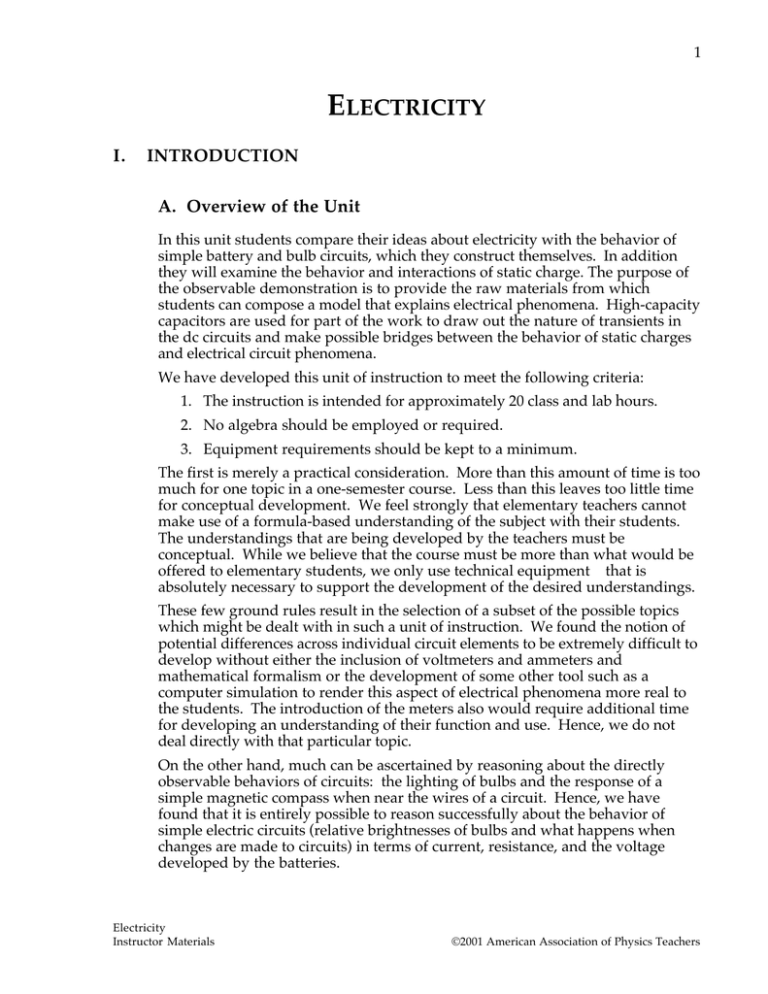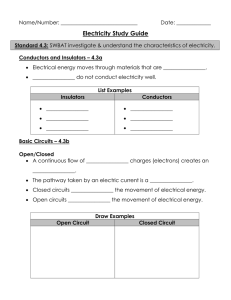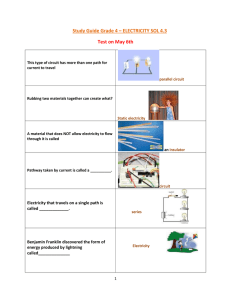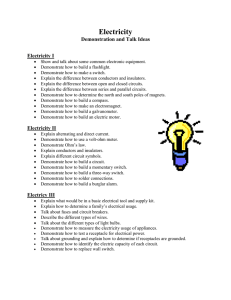electricity - American Association of Physics Teachers
advertisement

1 ELECTRICITY I. INTRODUCTION A. Overview of the Unit In this unit students compare their ideas about electricity with the behavior of simple battery and bulb circuits, which they construct themselves. In addition they will examine the behavior and interactions of static charge. The purpose of the observable demonstration is to provide the raw materials from which students can compose a model that explains electrical phenomena. High-capacity capacitors are used for part of the work to draw out the nature of transients in the dc circuits and make possible bridges between the behavior of static charges and electrical circuit phenomena. We have developed this unit of instruction to meet the following criteria: 1. The instruction is intended for approximately 20 class and lab hours. 2. No algebra should be employed or required. 3. Equipment requirements should be kept to a minimum. The first is merely a practical consideration. More than this amount of time is too much for one topic in a one-semester course. Less than this leaves too little time for conceptual development. We feel strongly that elementary teachers cannot make use of a formula-based understanding of the subject with their students. The understandings that are being developed by the teachers must be conceptual. While we believe that the course must be more than what would be offered to elementary students, we only use technical equipment that is absolutely necessary to support the development of the desired understandings. These few ground rules result in the selection of a subset of the possible topics which might be dealt with in such a unit of instruction. We found the notion of potential differences across individual circuit elements to be extremely difficult to develop without either the inclusion of voltmeters and ammeters and mathematical formalism or the development of some other tool such as a computer simulation to render this aspect of electrical phenomena more real to the students. The introduction of the meters also would require additional time for developing an understanding of their function and use. Hence, we do not deal directly with that particular topic. On the other hand, much can be ascertained by reasoning about the directly observable behaviors of circuits: the lighting of bulbs and the response of a simple magnetic compass when near the wires of a circuit. Hence, we have found that it is entirely possible to reason successfully about the behavior of simple electric circuits (relative brightnesses of bulbs and what happens when changes are made to circuits) in terms of current, resistance, and the voltage developed by the batteries. Electricity Instructor Materials ©2001 American Association of Physics Teachers 2 B. Acknowledgments and Origins of Ideas A number of efforts have focused on the issue of understanding electric circuit phenomena. We are indebted to the ongoing work of our colleagues. Differing goals and boundary conditions preclude our use in their entirety of any of these excellent efforts. We have included a number of elements from several projects to create a coherent, effective unit. We have knowingly included ideas from • The lessons on "Batteries and Bulbs," which have been used in a number of projects, originally appeared in the Elementary School Science (ESS) Project, • The Mel Steinberg's CASTLE Project, most notably using large capacity (0.25 to 0.49 Farad) capacitors, • The AAPT Electrostatics Workshop developed by Robert Morse, Rodney Labrecque, Peter Shaffer, and Richard Heckathorne, • The recent work of Bruce Sherwood and Ruth Chabay at Carnegie Mellon University, • The work of Samuel Joshua and Jean-Jacques Dupin in France, • The Physics Learning Research Group at CRMSE at San Diego State University under the direction of Fred Goldberg, • The Physics Education Research Group at the University of Washington under the direction of Lillian McDermott, and • The work of Arnold Arons, Professor Emeritus, University of Washington. C. General Safety Considerations The equipment and its configurations for this unit are similar to everyday uses of the equipment. It is possible when the batteries are fresh to get a piece of wire shorted across them that's hot enough to surprise the students or possibly cause minor burns. While we fear that up-front emphasis of the potential dangers might add to the fear of electricity already held by some students, it would be best to use plastic insulated wire and insist that circuits with more than one battery include a tap switch at all times. The tap switch also serves to help batteries last the duration of the unit. A second possible problem is loss of integrity of the battery cases. This happens with faulty batteries and with old ones. Both should be avoided and any mess cleaned up quickly when it does occur. We have found that it is best to purchase an adequate amount of quality, name-brand batteries both to avoid leakage problems and so that they will last throughout the whole unit. The third potential problem is the danger of cuts from broken bulbs. If a bulb is broken, the students should have the opportunity to observe the inside of the bulb, but the bulb and its pieces should be handled carefully. ©2001 American Association of Physics Teachers Electricity Instructor Materials 3 II. STUDENTS' NOTIONS ABOUT ELECTRICITY A. Students' Prior Beliefs as Described in the Research on Student Conceptions Student conceptions about electricity and electric circuits is one of the more extensively studied topics in physics although student notions about electricity have not been studied to the same extent as elementary mechanics. From junior high school to college age, students have been found to display a reasonably predictable set of ideas about electricity, despite the typical instruction which they might receive during elementary, junior high school, and high school. In this section we describe frequently found aspects of student thinking about electricity. There are three important aspects of student ideas about electricity which may explain many of the details described in the research: the undifferentiated nature of their ideas about these phenomena, the tendency to think as if some material substance and its motion is responsible for the phenomena, and the tendency to think locally or sequentially about events in circuits. First, with respect to electricity in particular students are not thinking about current or electricity as we think of them, but of some undifferentiated entity, which they call electricity, that is much more like energy than current—often in interviews they use a whole list of terms instead of just one, as if they all mean the same thing. Hence, it is very misleading to suggest that students have notions about electrical current when they come to class. Second, students think of this undifferentiated entity, electricity, and the subentities, current and electrical energy, as if there were a material substance which flows from a source in the circuit to other points in the circuit and which gets used by other circuit elements. This tendency to think in terms of material substances has been noted in studies of student thinking in other areas of physics, heat and light among them. The "material substance" notion can serve to explain why direction of flow is important to them and their tendency to predict bulb brightness based on location in the circuit. The apparent tendency to think of batteries as sources of constant current or of the same current to all circuits or as a storage container for electricity and to think of bulbs as consumers, rather than as resistances is consistent with these general notions. Because these notions work well enough for everyday activities, a need for a more sophisticated model of "electricity" flow does not normally occur. Electricity Instructor Materials ©2001 American Association of Physics Teachers 4 A third, but not independent, tendency in student thinking about electricity which has been identified is called "sequential" or sometimes "local" reasoning about circuits. Students tend to think of this substance, electricity, which comes from a source such as a battery and which encounters various circuit elements one at a time as it flows from the battery through the wire around the circuit. What happens at each element seems to depend somewhat on what has already been encountered, mostly on the specific element in question, but definitely not on what the substance may encounter next or further down the line. Sometimes the students' ideas seem as if only the circuit element being directly considered matters (local consideration) and its relation to the other elements in the circuit (global consideration) is not important. A manifestation of this is the tendency to assume that the addition of a resistance always makes the circuit resistance go up and vice versa for the removal of a resistance. Conceptions that Characterize Student Thinking about Electricity 1. Electricity as an undifferentiated entity which includes energy, current, voltage, etc., sorts of ideas 2. Electricity as a "substance" which flows from a source 3. Sequential or local reasoning about events which occur in a circuit These notions seem to be well entrenched and typical instruction does little to make changes in these ideas. They even remain in our language about electrical circuits. For example, it is common among technicians, engineers, and physicists to refer to a battery or power supply as "delivering" a certain current. Even the very term "power supply" conveys this notion. Unfortunately, using the term "generating" in this case hardly helps distinguish the two pictures of electricity. One has to ask to what extent do many of these more highly trained individuals still harbor the general kinds of thinking about electricity described above? On a more pedestrian level, students do not always easily relate aspects of circuit diagrams with real circuit elements such as wires, bulbs, batteries, etc. This is not too surprising given that they previously have neither needed to use such a representation nor had any real experiences which would give them practice at such connections between the representation and the actual circuit. From a slightly different, but complementary, point-of-view researchers have noted that students appear to apply several different models for the functioning of electricity in circuits. These models are not always explicit to the students themselves, but student behavior is consistent with some of these models. They are not necessarily models in the scientists' sense, but they are mechanisms that can be mentally "run" to make predictions about electric circuits. These models are listed in the following table: ©2001 American Association of Physics Teachers Electricity Instructor Materials 5 Student Models of the Behavior of Electricity in Circuits 1. Unipolar: electricity comes from only one pole of battery, no return wire needed (also called total consumption model) 2. Clashing: electricity comes in opposite directions out of each end of battery and clashes at the bulb causing light 3. Consumption: electricity comes out of one end of the battery and gets "used up" as it passes through circuit elements, some gets back, so a return wire is needed (also called the partial consumption model) 4. Sharing: electricity is shared by all circuit elements Often the model that scientists use is not in evidence in any student's thinking. We will call it a constant flow model so as not to prejudice thinking about it. Its main characteristics are that there is something that seems to circulate around the circuit essentially unabated (the current) and something else that seems to be dissipated (energy). Note that some aspects of the characteristic conceptions about electricity and some aspects of the models of electrical circuit behavior are compatible with the ideas about electricity we would like them to have developed by the end of this unit. Hence, our focus should be to encourage students to consider at all times what is worth keeping and what should be abandoned about the various ideas that occur to them. B. Conceptions that Students Might Develop In the Electricity unit students are invited to consider a number of specific situations in which their predictions based on the conceptions they already have are not in agreement with the outcome in those situations. As a result, the students, if given encouragement, may modify their ideas to be something more like the scientists' view. The view that we find students are able to develop in this unit and we hope to have all students develop at this level goes something like the description below. Electricity seems to be a set of phenomena explainable in terms of interactions of charges and the movement of those charges which seem already to exist in the wires through which they move. In addition to something that appears to be used up, there appears to be another aspect of electricity which circulates completely around a circuit with no losses. This latter we call current and associate with the rate of passage of charges. Also, bulbs do not consume the charges, but act to resist the passage of charges. Electricity Instructor Materials ©2001 American Association of Physics Teachers 6 These charges move in response to forces which, on an individual, microscopic scale, are like the forces between charged objects, but on a global circuit level this influence on the motion of the charges is attributed to voltage or potential difference provided by a battery or other charge-accumulating device such as a capacitor. In this view batteries do not create the charges, they are already there, but batteries move the charges. In this role, batteries are not unique. Charges squeezed together in a storage device such as a capacitor, push each other out given the opportunity and can thus act as a source of moving charges for a time. Other mechanical devices apparently accomplish the same thing such as the Genecons which can be used in the unit. Unless there is an unbroken path through each of the elements of a circuit, in one end and out the other, connected by wires in the form of a closed loop around which the charges can circulate, there will be no long-term circulation as there will inevitably be a build up of charge somewhere, which will eventually build up a repulsion to match any other driving forces in the circuit causing the movement of charge to stop. This new notion of electricity that differentiates various aspects of electricity, which we might refer to as energy, current, and potential difference, raises new issues. The first of these is the relationship between current, resistance, and voltage. Fortunately, a pervasive notion that most people already have and routinely use is that the bigger the effort the bigger the result and the larger the resistance the smaller the result, resistance and effort held constant, respectively. This generally "ohmic" notion about the relationship between effort, result, and resistance seems to transfer fairly easily to the electrical situation for the students. To go on with the sort of view we find that students can develop: The behavior of circuits are viewed in terms of each element functioning in relationship to the sum of the rest of the components. What happens in the circuit due to a change in one element, bulb for example, depends on that element's relation to the entirety of the circuit. The everyday view would be that if a bulb is added then resistance is added and therefore current would go down in general. The new view results in considering whether charges passing through other elements of the circuit must also pass through this new element. Herein lies the essence of the distinction between parallel and serial configurations. With this new view students are able to accurately determine relative brightnesses and changes in brightness of bulbs in circuits containing five bulbs or so in varying configurations of parallel, serial, and combinations when a bulb is added, removed, shorted or opened. ©2001 American Association of Physics Teachers Electricity Instructor Materials 7 III. COGNITIVE RATIONALE Investigation E1: Batteries and Bulbs Our general approach in the first investigation is to ask students to consider their ideas about electric circuits and then look at the actual behavior of the circuits. This serves two purposes. First, it is a basis for eliciting student ideas about electric circuits, and it gives students hands-on experiences with circuits and their construction. Since we believe that it is useful and a valuable habit of mind to try to form a more or less mechanical model in order to make sense of physical phenomena, the approach is to get the students to suggest and then critique possible models for electricity based on the circuits in this first investigation. Investigation E2: "Obstacleness" and "Oomph" In the second investigation, the students are invited to consider aspects of electrical circuits for which they already have some ideas and will match their observations on the circuits. We start by referring to these notions using nontechnical terms, "obstacleness" and "oomph," and after looking at the behavior of circuits in this context we introduce the terms resistance and voltage. The students at this point do not have a physicists' view of the nature of these terms. This is not possible to achieve in the time available, but it is the case that they do have suitable views at the level to which we need to go with other aspects of the material on electricity in this unit. Investigation E3: Capacitors and Their Effect on Electricity The purpose of the third investigation is to get the students to consider more about the nature of this "material" which seems to move around the circuit by confronting the dilemma of the behavior of the circuits with capacitors. What possible models could account for the behavior of the circuit? What might one hypothesize about the nature of the "electrical stuff" and or the capacitor itself? Does one have to conclude that the flow stops eventually, and what significance might one draw from this? It is intended that the students will decide that somehow the capacitor stops the electricity, but not right away and that either the capacitor as a "container" is elastic or that the "stuff" of the electrical current is compressible. Electricity Instructor Materials ©2001 American Association of Physics Teachers 8 Investigation E4: Electric Charge The fourth investigation is intended merely to familiarize the students with the behavior of charged objects. In particular that charged objects can influence each other at a distance and that they can be squeezed together even when they repel each other. Activities E4.3, E4.4, E4.7, and E4.8 plus the letters from Benjamin Franklin would be the basic material here, anything else in the investigation is extra and, as such, is optional. This investigation is intended to occupy only a small amount of time and the relevant parts be done in full class, seat work mode. The basic idea is to be able to end up with a plausible model of what the "stuff" of the current might be and from that a model of the capacitor. Be warned, that the scientists' notion of metals as atoms with some electrons free to move around is not anywhere near the notion of solids that the students come to class with. That they have had courses in chemistry and can say things about atoms and electrons notwithstanding, it is painfully clear that more often than not this plausible (to us the instructors) model of electricity involving moving electrons in the metals does not find much to relate to in many students' thinking. One might want to consider whether or not to even deal with the notions in this investigation. It might suffice to go with what can be concluded in Investigation 3 as to the nature of the "stuff" of the current. Investigation E5: Batteries, Bulbs, and Capacitors In the fifth investigation, we go back to the capacitors, armed with at least the ideas that can be generated as of the end of the third investigation and look at other aspects of the behavior of circuits containing capacitors. The intention here is twofold. One is to get at the idea that whatever it is that is moving in the circuit, it must already be there when the switch is closed, hence, the battery is not the source of the current. The wires are already "full" of the stuff that moves. How else can one explain that the bulb lights on the other side of the capacitor and between capacitors, if the capacitors themselves are barriers to the movement of the "stuff" of the current? The second major idea is to look back at current in the context of different resistances and try to separate the notion of the amount of "stuff" of the current and the rate at which it moves, i.e., in scientists' terms charge from current. Investigation E6: Circuits with Multiple Paths The sixth investigation is a look at more complicated circuits. The counterintuitive idea that adding bulbs in this setting apparently reduces the resistance is confronted. The issue of the batteries running down for various of these configurations against the previous circuits considered is revisited. At this point it is also possible to get the students to bring out some other common notions which do not work in the context of the circuits such as: Batteries always supply the same current. ©2001 American Association of Physics Teachers Electricity Instructor Materials 9 Investigation E7: Electric Circuits In the final investigation, the students consider combination circuits; ones that are neither simply series or multiple-path (parallel). Here they have to bring together all the ideas built so far. Their notions at the beginning of the investigation have come a long way from what they were when they started, but there are still vestiges of the old ideas, and the new ones are not always coordinated with each other. In the previous investigation and this one, the notion of equivalent resistance is an important issue that can be used to aid in the prediction of what will happen in various combination circuits. Electricity Instructor Materials ©2001 American Association of Physics Teachers 10 IV. INSTRUCTOR NOTES A. Equipment List Equipment Per lab group of 4 Aluminum pie plates 2 Battery D-cell 4 Blue foam insulation square 60 cm x 60 cm 2 Bulb (oblong #47) 4 Bulb socket for oblong #47 4 Compass 1 Copper wire (22 gauge, 6 m) 1 Flashlight 1 Four-battery holder 1 NEC Super Cap™ Capacitor 0.49 F, 10 V 1 Rabbit fur 1 Scotch removable magic tape 1 Sponge 1 Table edge or stand and 1 m length of wood 1 Tap switch 1 Wire with alligator clips 12 Wire with metal ends exposed 1 Per class for Demonstration For unit ZiplocTM bags for storage of equipment Note: In activity E3.3, E5.3, E7.1, and E7.2, two groups must share the following equipment in order to perform the activity: NEC Super Cap Capacitors Four-battery holders D-cell batteries ©2001 American Association of Physics Teachers Electricity Instructor Materials





